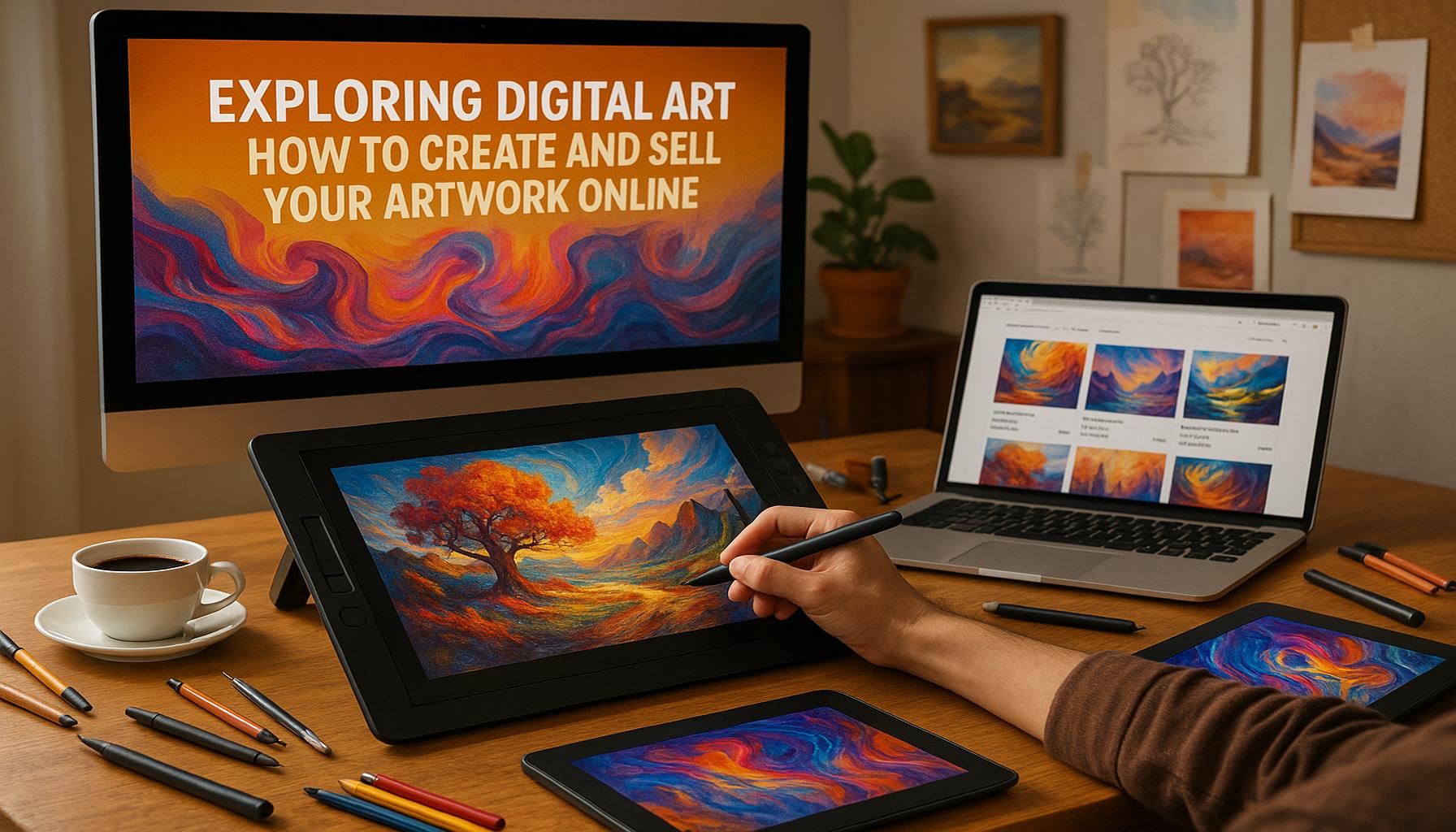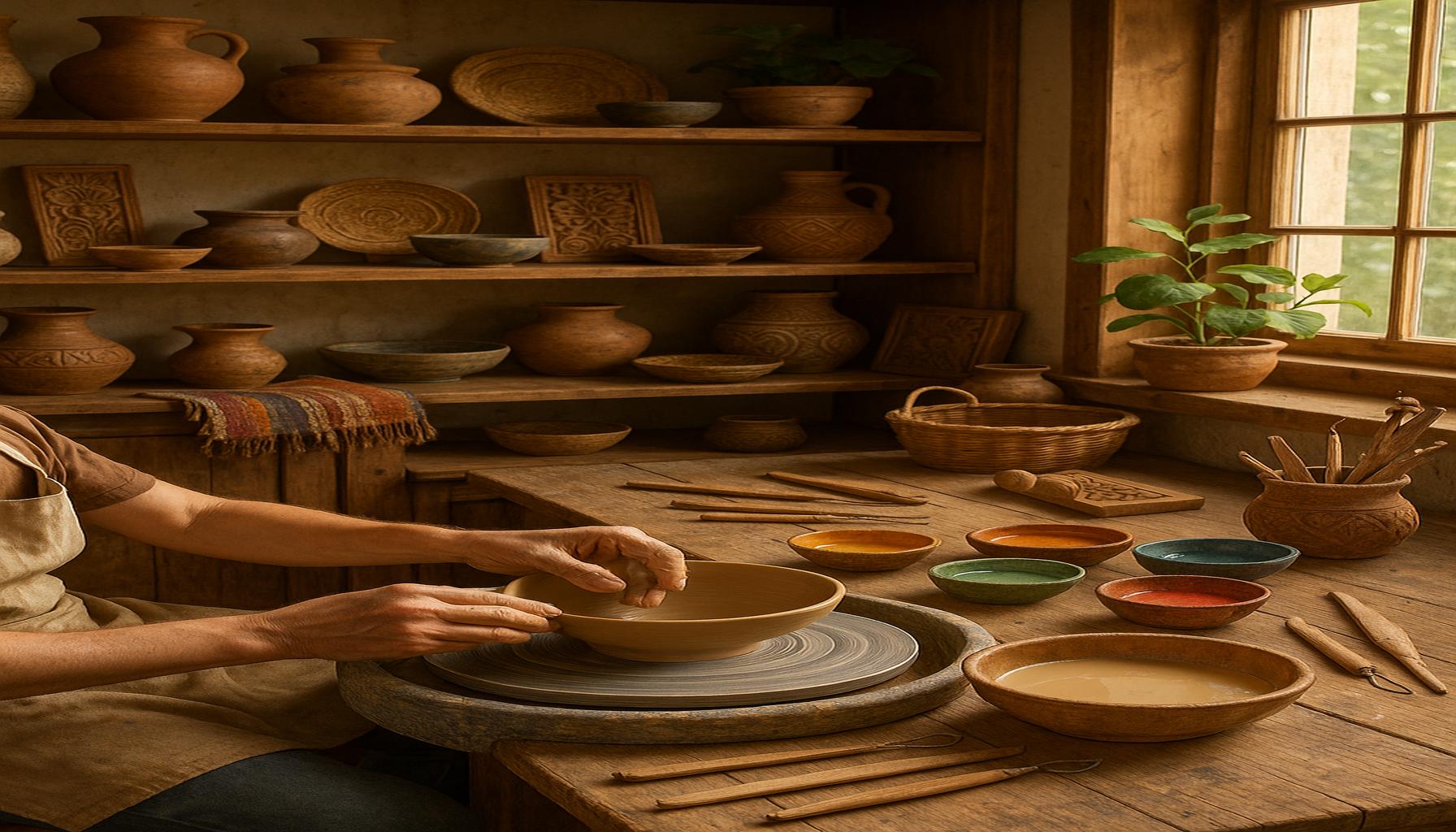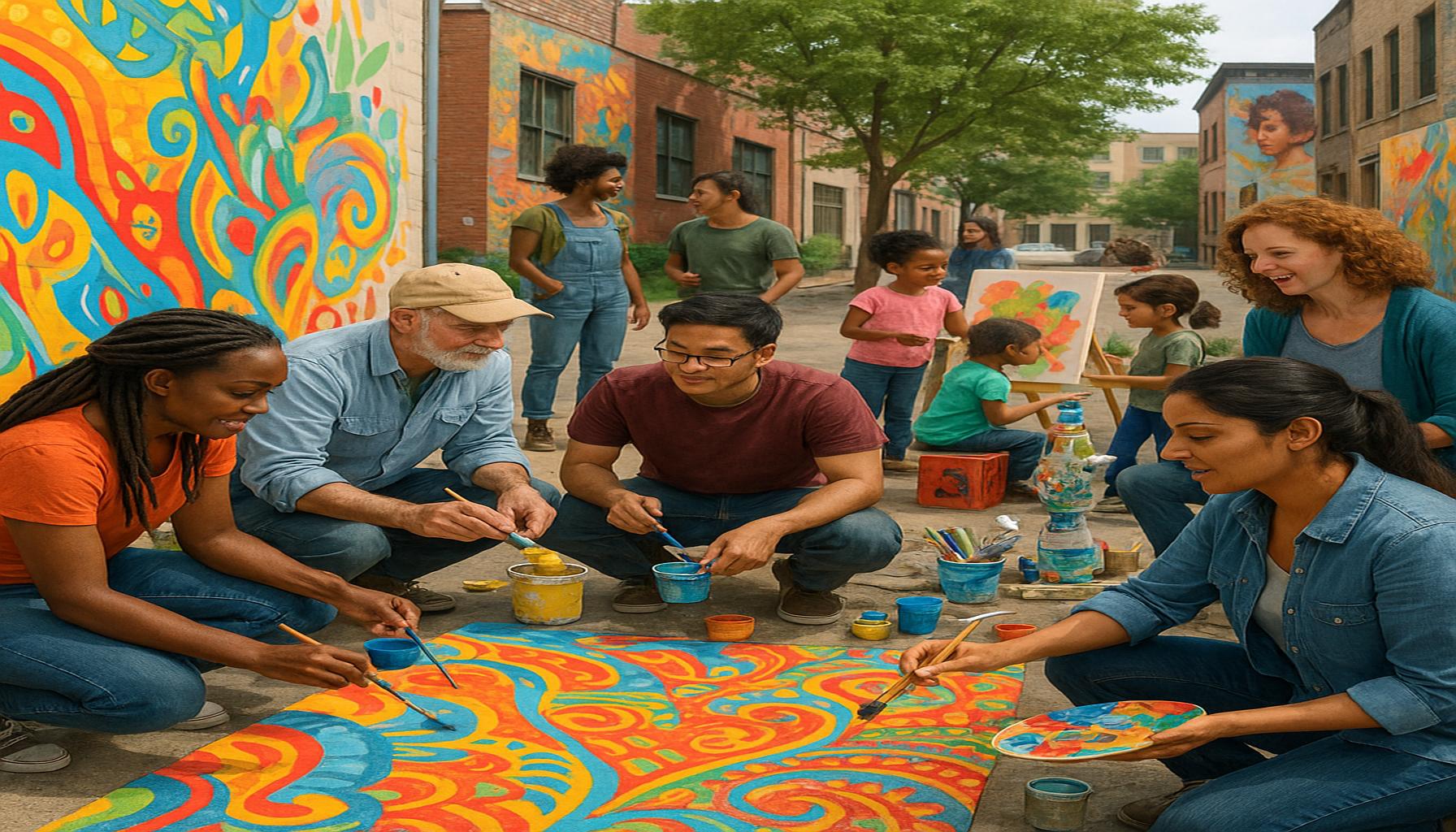Exploring Digital Art: How to Create and Sell Your Works Online

Exploring the Spectrum of Digital Art
The world of digital art is an ever-evolving environment that intertwines creativity with the latest technological advancements. Artists are no longer confined to traditional media; instead, they can harness the power of digital tools to produce captivating works that can reach larger audiences than ever before. From the sleek interfaces of graphic design software to innovative new apps, the opportunities for artistic expression are virtually limitless.
Creating digital art transcends mere utilization of software; it encompasses an exploration of various artistic styles and techniques. Key forms include:
- Digital painting – This technique allows artists to mimic traditional painting styles by using tools such as brushes and layer techniques in platforms like Adobe Photoshop or Procreate. For instance, artists can use brushes that replicate oil paints, watercolors, or even textured pastels to give their artwork depth and a genuine, handcrafted feel.
- Vector art – Utilizing mathematical paths, this form produces images that remain crisp at any size. Software like Adobe Illustrator is invaluable for designing logos or creating illustrations for various media because the images generated with vector art technology adapt seamlessly across different formats without losing quality.
- 3D modeling – With software like Blender or Autodesk Maya, artists can create intricate three-dimensional objects that look lifelike. This technique is especially prominent in gaming and film, where artists develop characters and environments that enhance immersive storytelling experiences.
Once your creative skills are refined, understanding how to effectively share your work is a vital next step. The digital landscape provides myriad avenues for artists to market and sell their creations:
- Online marketplaces – Platforms such as Etsy or Redbubble allow artists to open digital storefronts where they can sell prints, merchandise, or even digital downloads of their art. This broadens their reach to potential buyers all around the globe.
- Social media platforms – Using channels like Instagram, Facebook, or TikTok can significantly boost an artist’s visibility. Engaging with communities through regular content and direct interaction can help foster a dedicated following, leading to increased sales and opportunities for collaboration.
- Personal websites – Creating a visually appealing online portfolio provides a professional space for artists to showcase their work, blogs about their creative process, and connect with customers directly, further establishing their brand.
By intertwining creativity with astute marketing strategies, artists can carve out successful careers in the expansive domain of digital art. The combination of artistic talent and business acumen is essential for thriving in this competitive field. Therefore, if you’re an aspiring creator, it’s time to dive deeper into the world of creating and selling digital art. The vast opportunities awaiting you could lead to a fulfilling and prosperous artistic journey.
DIVE DEEPER: Click here to discover relaxation crafting techniques

Harnessing the Tools of Digital Creation
As the realm of digital art expands, artists are presented with a myriad of tools that cater to different styles and preferences. Choosing the right software or hardware is crucial for unleashing creativity. Here’s a breakdown of some prominent tools that can help you kickstart your digital art journey:
- Graphic Tablets – You can enhance your workflow with devices such as the Wacom Intuos or XP-Pen Artist. These tablets allow for a natural drawing experience, mimicking the feel of traditional mediums while allowing for versatile digital techniques.
- Software Solutions – Programs like Adobe Photoshop and Corel Painter have long been staples for digital painters. However, newer entrants like Krita and Affinity Designer provide affordable and intuitive alternatives for budding artists. Each software offers unique features tailored for various artistic approaches.
- Mobile Applications – For on-the-go creativity, apps such as Procreate Pocket and Autodesk Sketchbook transform your smartphone or tablet into powerful art platforms. Their flexibility allows artists to sketch and create illustrations anywhere and at any time.
Your choice of tools will greatly influence your artistic expression. While some artists prefer the sophistication of a graphic tablet combined with powerful software for intricate designs, others might find more spontaneity and freedom in mobile applications that allow for quick sketches or idea generation.
Mastering Your Technique
Creating exceptional digital art isn’t just about selecting the right tools—it’s also essential to develop your craft through practice and experimentation. Several techniques can elevate your work:
- Layering – Understanding how to effectively use layers can greatly enhance your work. This technique allows artists to edit different elements separately, giving them the freedom to adjust, recolor, and transform distinct components without altering the entire piece.
- Texturing – Adding texture can infuse depth and life into your creations. Artists can use brushes, patterns, and overlays to simulate various surfaces, enriching the viewer’s experience and making the artwork more engaging.
- Color Theory – Mastery of color can evoke emotions and convey messages. A keen understanding of color relationships, palettes, and the psychological implications of colors helps artists create more compelling pieces.
As you refine your skills and explore various techniques, consider documenting your artistic process. Sharing time-lapse videos or step-by-step tutorials on platforms like YouTube or TikTok not only showcases your talent but also gives insight into your methodology, further connecting with your audience.
Taking the time to explore these tools and techniques opens doors to innovative creations that can captivate audiences. Whether scaling through traditional methods adapted for a digital framework or experimenting with a novel approach, the artistic possibilities are endless. The next stage involves not just creation, but unveiling your art to the world—ensuring your unique voice resonates with potential buyers online.
Exploring the Platforms for Selling Digital Art
In the era of technology, artists have a plethora of platforms at their disposal to showcase and sell their digital artworks. These platforms not only provide a marketplace but also help artists reach a broader audience, enhancing their visibility and potential sales. One such platform is ArtStation, which has become a go-to site for digital artists. It allows users to create portfolios, share work, and connect with creative professionals worldwide. Another notable platform is Etsy, which enables artists to set up personal shops to sell their artworks, including prints and downloadable files.
Understanding Digital Art Licensing
An essential aspect of selling digital art is understanding licensing. Artists can choose to sell their works under various licensing terms, which dictate how buyers can use the art. Licensing options can range from limited commercial licenses, which permit specific uses, to complete ownership transfers. By retaining copyright while offering limited licenses, artists can maximize their income while maintaining control over their creations.
Engaging with Your Audience
Establishing a connection with your audience can significantly influence your success in the digital art marketplace. Utilizing social media platforms, such as Instagram and Twitter, helps artists share their creative processes, gain feedback, and attract potential buyers. Regular interaction with followers also builds a loyal community, encouraging repeat customers who value unique, relatable artistry. Hosting live art sessions or tutorials can further deepen engagement, allowing audiences to appreciate the effort behind each piece and fostering a sense of personal connection.
| Category | Benefits of Exploring Digital Art |
|---|---|
| Access to Global Markets | Engage with a diverse audience, transcending geographical boundaries. |
| Lower Entry Costs | Reduced financial barriers to starting and promoting your art through digital channels. |
| Increased Visibility | Marketing tools enhance exposure, boosting sales opportunities dramatically. |
With the right strategies and tools at your disposal, selling digital art can be a rewarding and profitable venture, offering endless opportunities for creativity and expression.
DIVE DEEPER: Click here to discover the power of writing as therapy
Building Your Online Presence
After honing your skills and creating captivating artworks, the next pivotal step is to develop your online presence for showcasing and selling digital art. In this digital age, having a strong and professional online profile can significantly enhance your reach and visibility in the art marketplace. Here are several platforms and strategies to consider:
- Social Media Platforms – Utilize platforms like Instagram, Pinterest, and TikTok to share your art. Visual-first platforms like these are particularly effective for artists, allowing you to connect with audiences and cultivate a following. Engaging posts, behind-the-scenes content, and interactive stories can help in building your brand.
- Online Portfolios – Creating a dedicated portfolio website is crucial for establishing a professional presence. Websites like Behance, ArtStation, and even custom sites hosted on platforms like Squarespace or Wix, allow you to display your work in a visually appealing manner that reflects your style and artistic voice.
- Online Marketplaces – Selling your art through online marketplaces like Etsy, Redbubble, and Society6 can provide a significant income stream. These platforms are designed for artists, making it easier to manage sales transactions, while also bringing exposure to a vast audience actively seeking art.
Establishing an online presence is not just about showcasing your work; it’s also about networking with other artists and potential buyers, which can lead to collaborative opportunities and exposure to different art communities.
Effective Marketing Strategies
Once you have established your online presence, adopting effective marketing strategies is essential to attract buyers and increase sales. Here are valuable tactics to consider:
- Content Creation – Create engaging and educational content related to your art. Consider writing blogs about your creative process, sharing tips on digital art techniques, or discussing trends in the art world. This will not only establish your authority as an artist but also improve your website’s SEO, drawing more traffic toward your portfolio.
- Email Marketing – Building a mailing list can be invaluable. Offering a newsletter where you share updates, exclusive deals, or upcoming projects helps maintain a direct connection with your audience, prompting repeat visitors when you launch new works.
- Collaborations – Collaborating with other creators or brands can expose your work to their audiences. Joint projects, giveaways, or features can attract new followers who appreciate both your work and that of your collaborators.
Incorporating these strategies can create a comprehensive marketing approach, enabling you to reach a broader audience and facilitate growth in your digital art business.
Understanding the Market
To successfully sell your digital artworks, familiarity with the market trends is paramount. Recognizing what sells and understanding audience preferences can help you tailor your creations. Here are some insights you might find useful:
- Popular Styles – Research current trends in digital art, such as minimalism, retro, or surrealism. Stay updated via online communities, social media, or digital art forums to discern what resonates with potential buyers.
- Pricing Strategies – Determining fair prices for your artwork is critical. Consider factors such as your experience level, the time invested in creating the work, and the prices of similar pieces in the market. A balanced pricing strategy can attract buyers while ensuring you value your art appropriately.
- Target Audience – Identify your target audience based on your style and themes. Engaging with specific communities, whether they are fans of fantasy art, portraits, or abstract pieces, can help you market your work more effectively.
By understanding market dynamics and consistently innovating your approach, you can effectively position your digital art in the online landscape, guiding potential buyers to your unique creations.
EXPLORE MORE: Click here to dive deeper into the power of personal diaries
Conclusion: Embracing the Digital Art Revolution
In the ever-evolving world of digital art, the potential for creativity and commerce is limitless. As we have explored, honing your craft is only the first step in a journey that requires strategic planning, effective marketing, and a deep understanding of the market. Establishing a significant online presence through social media, portfolio websites, and online marketplaces can effectively connect you with a wide audience eager for unique artistic expressions.
The importance of effective marketing strategies cannot be understated. By leveraging content creation, email marketing, and collaborations, you can engage potential buyers while fostering a loyal community around your art. As these methods drive traffic to your works, remember that storytelling can be a powerful ally—sharing insights about your creative process can elevate your art’s value and resonate on a personal level with viewers.
Equally important is the necessity to stay informed about market trends. Understanding popular styles, implementing fair pricing strategies, and accurately identifying your target audience will not only help you navigate the competitive landscape but also allow you to position your work compellingly. As you embrace these strategies, continually adapt to the changing dynamics of the digital art scene.
In conclusion, the journey of creating and selling digital art online is an invitation to explore your passions while crafting a fulfilling business. By merging your artistic skills with effective online techniques, you can not only share your gift with the world but also build a sustainable career in the vibrant realm of digital art. The possibilities are endless—step out, create, and let your artistic voice be heard.


